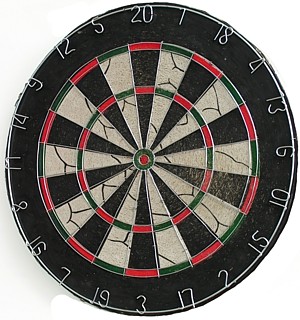A dart board is the target for the game of darts, in the same vein as the round bullseye target used in archery. It is believed that warriors during the Middle Ages would take turns throwing short spears at overturned barrels or round targets formed from a tree's cross section. This improvised game would later be refined for indoor use by creating small darts and a standardized wooden board.
A traditional dart board used with sharp steel-tipped darts can be constructed from soft wood, cork or even compressed paper. The board used in modern electronic dart games is often constructed from a plastic material perforated with holes. Soft-tipped darts are used to protect it from damage. The material used in a dart board rarely affects playing strategy, but some darts may not penetrate a wooden board as easily as a cork one.

The standard diameter of a tournament dart board is 15.5 inches (39.4cm). Official dart rules call for the center of the bullseye to be placed 5 feet 8 inches (173cm)from the ground, and 7 feet 9 1/2 inches (237cm) from the player. This is not the distance measured from the wall, but from the face of the board. The area around the board should provide some protection from errant throws. Professional dart venues often install a wooden plank called an 'oche' precisely over the boundary line for throwers. The oche prevents feet and other body parts from crossing into foul territory.
 A traditional dart board features the numbers 1-20 placed around the perimeter area in the following arrangement:
A traditional dart board features the numbers 1-20 placed around the perimeter area in the following arrangement:
(top) 20 - 1 - 18 - 4 - 13 - 6 - 10 - 15 - 2 - 17 - 3 - 19 - 7 - 16 - 8 - 11 - 14 - 9 - 12 - 5
No one is quite sure why this particular sequence was chosen, but some mathemeticians theorize that the distribution is 'flat', meaning it is random enough to prevent any point-rich regions.
The numbers are further divided into wedges leading to the center of the board. Two concentric rings denote areas where point values are doubled and tripled. The bullseye is scored as 50 points, while the ring surrounding it is worth 25 points. Bulleyes are actually not worth as much as a dart landing in the 'triple 20' section. Good players spend hours perfecting throws to this particular section of the dart board.
There are literally hundreds of games and variants played on a dart board, but one popular game is called '301'. Two players begin the game with identical scores of 301 points. The idea is to reach exactly 0 points before your opponent. Each player throws three darts and the resulting score is subtracted from the previous effort. For example, if the first player earns 100 points during the first round, his new score is 201. The second player may score 50 points, which makes his score 251. Each player continues to subtract their scores from their previous results until one of them reaches 0. The catch is that any score which would result in a negative number cannot be counted. The player's score remains where it was before the round. This can give an opponent many chances to catch up in the scoring. If the player's score is 17, he must either hit a single 17 point shot or a combination leading to exactly 17 points. Strategy is just as important as skill when playing tournament darts.
